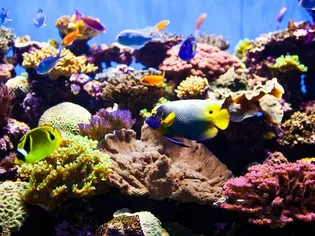What Is a Reef Tank?
Updated on 05/26/24

Discover the Enchanting World of Reef Tanks: A Comprehensive Guide
Immerse yourself in the captivating realm of reef tanks, where the vibrant colors and diverse life of coral reefs are brought to life within the confines of your home. In this comprehensive guide, we delve into the intricacies of reef tank ecosystems, providing you with the knowledge and insights to create and maintain a thriving underwater paradise.
What is a Reef Tank?
A reef tank is a specialized aquarium that mimics the conditions of a natural coral reef, providing a habitat for a wide array of marine life, including corals, fish, invertebrates, and algae. Unlike traditional aquariums, reef tanks prioritize the creation of an ecosystem that supports the unique needs of these delicate organisms.
Benefits of Reef Tanks
* Aesthetics: Reef tanks are living works of art, transforming any space into an underwater oasis. The vibrant colors, intricate textures, and diverse life forms create a captivating visual masterpiece.
* Education: Reef tanks provide an unparalleled opportunity to learn about the wonders of marine biodiversity and the delicate balance of ocean ecosystems.
* Stress Relief: Studies have shown that observing reef tanks can have a calming effect, reducing stress levels and promoting relaxation.
* Conservation: By keeping reef tanks, hobbyists contribute to the preservation of marine life. They support the captive breeding of endangered species and provide a safe haven for creatures threatened by habitat loss and overfishing.
Types of Reef Tanks
* Fish-Only Reef Tanks: These tanks focus primarily on showcasing tropical fish species, with minimal emphasis on corals. They are suitable for beginners and provide a lower-maintenance option.
* Reef Tanks: These tanks include both fish and corals, offering a more comprehensive representation of a reef ecosystem. They require more specialized equipment and care but provide a truly immersive experience.
* Nano Reef Tanks: These compact tanks, typically under 30 gallons, are ideal for limited spaces or those just starting their reef-keeping journey.
Equipment for Reef Tanks
* Aquarium: Choose a tank with adequate size and features to accommodate your desired livestock and corals.
* Filtration System: A robust filtration system, such as a protein skimmer and biological filter, is crucial for maintaining water quality and removing waste.
* Lighting: Corals require specific lighting conditions to thrive. Choose LED or metal halide fixtures that provide the appropriate intensity and spectrum of light.
* Circulation Pump: A circulation pump creates water movement, mimicking the currents found in natural reefs and ensuring even distribution of nutrients.
* Heater: A heater is essential for maintaining the optimal temperature range for your chosen marine life.
Livestock for Reef Tanks
* Corals: Corals are the foundation of reef tanks, providing shelter, food, and color. Choose species that are compatible with your system and care level.
* Fish: Fish add movement and character to reef tanks. Select species that are reef-safe and compatible with your corals and other livestock.
* Invertebrates: Invertebrates, such as shrimp, snails, and crabs, play important roles in reef ecosystems by cleaning, consuming algae, and providing food for other creatures.
Maintenance for Reef Tanks
* Water Changes: Regular water changes are essential for removing waste and maintaining water quality. Aim for 10-15% water changes weekly or bi-weekly.
* Feeding: Feed your livestock a balanced diet of live and frozen foods, with occasional supplements.
* Testing: Regularly test your water parameters (pH, alkalinity, ammonia, nitrite, nitrate) to ensure they are within the optimal range for your aquatic inhabitants.
* Algae Control: Algae is a natural part of reef tanks, but excessive growth can be detrimental. Implement algae control measures such as manual removal, nutrient reduction, or the use of algae-eating organisms.
Examples of Beautiful Reef Tanks
* The Great Barrier Reef Tank at the Georgia Aquarium: One of the largest and most impressive reef tanks in the world, showcasing a vast array of species from Australia's Great Barrier Reef.
* The Red Sea Reef Tank at the Shedd Aquarium: This tank transports visitors to the vibrant waters of the Red Sea, featuring stunning coral formations and a diverse range of fish.
* The Indo-Pacific Reef Tank at the Monterey Bay Aquarium: Home to a mesmerizing collection of marine life from the Indo-Pacific region, including a giant manta ray and thousands of colorful reef fish.
Conclusion
Reef tanks offer a window into the captivating world of coral reefs, providing endless opportunities for enjoyment, education, and fulfillment. Whether you are a seasoned aquarist or just starting your journey, this comprehensive guide has equipped you with the knowledge and insights to delve into the fascinating realm of reef tank ecosystems. Embrace the beauty and wonder of our marine treasures by creating a thriving reef tank of your own.
Explore More Pets

Freshwater Aquarium Filters
How to Deal With Cloudy Aquarium Water

Saltwater Aquarium Filters
How Do You Remove Chloramines From Tap Water?

Freshwater Aquariums & Habitat
Can I Keep My Koi Fish Inside?

Saltwater Aquariums & Habitat
14 Best Floating Plants for Your Aquarium

Freshwater Fish Health
How to Treat Ich on Freshwater Fish

Saltwater Fish Health
Fin Rot in Aquarium Fish

Freshwater Aquarium Filters
How to Do Aquarium Water Changes

Saltwater Fish Health
How Do Fish Get Parasites?
